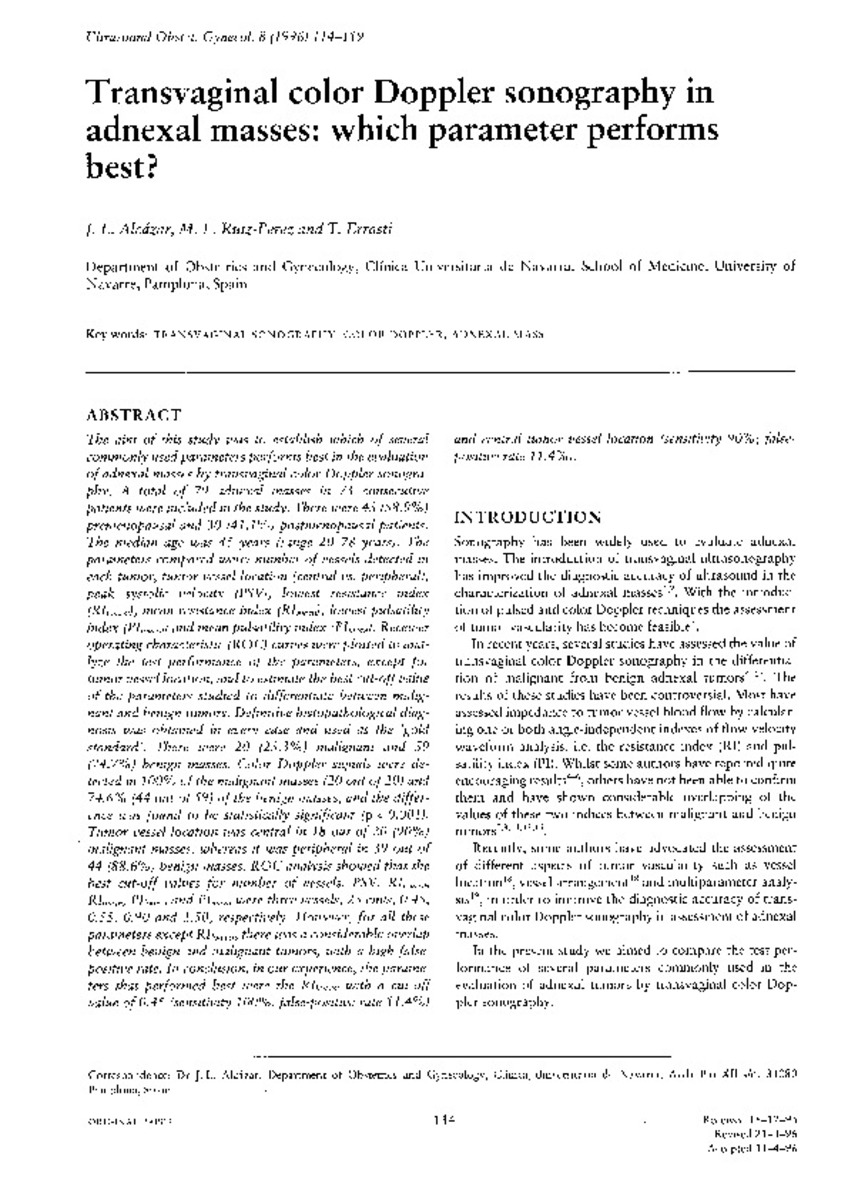Full metadata record
| DC Field | Value | Language |
|---|---|---|
| dc.creator | Alcazar, J.L. (Juan Luis) | - |
| dc.creator | Ruiz-Perez, M.L. (M. L.) | - |
| dc.creator | Errasti, T. (Tania) | - |
| dc.date.accessioned | 2012-10-29T12:25:52Z | - |
| dc.date.available | 2012-10-29T12:25:52Z | - |
| dc.date.issued | 1996 | - |
| dc.identifier.citation | Alcazar JL, Ruiz-Perez ML, Errasti T. Transvaginal color Doppler sonography in adnexal masses: which parameter performs best? Ultrasound Obstet Gynecol 1996 Aug;8(2):114-119 | es_ES |
| dc.identifier.issn | 0960-7692 | - |
| dc.identifier.uri | https://hdl.handle.net/10171/23508 | - |
| dc.description.abstract | The aim of this study was to establish which of several commonly used parameters performs best in the evaluation of adnexal masses by transvaginal color Doppler sonography. A total of 79 adnexal masses in 73 consecutive patients were included in the study. There were 43 (58.9%) premenopausal and 30 (41.1%) postmenopausal patients. The median age was 45 years (range 20-78 years). The parameters compared were: number of vessels detected in each tumor, tumor vessel location (central vs. peripheral), peak systolic velocity (PSV), lowest resistance index (RIlowest), mean resistance index (RImean), lowest pulsatility index (PIlowest) and mean pulsatility index (PImean). Receiver operating characteristic (ROC) curves were plotted to analyze the test performance of the parameters, except for tumor vessel location, and to estimate the best cut-off value of the parameters studied to differentiate between malignant and benign tumors. Definitive histopathological diagnosis was obtained in every case and used as the 'gold standard'. There were 20 (25.3%) malignant and 59 (74.7%) benign masses. Color Doppler signals were detected in 100% of the malignant masses (20 out of 20) and 74.6% (44 out of 59) of the benign masses, and the difference was found to be statistically significant (p < 0.001). Tumor vessel location was central in 18 out of 20 (90%) malignant masses, whereas it was peripheral in 39 out of 44 (88.6%) benign masses. ROC analysis showed that the best cut-off values for number of vessels, PSV, RIlowest, RImean, PIlowest and PImean were three vessels, 25 cm/s, 0.45, 0.55, 0.90 and 1.50, respectively. However, for all these parameters except RIlowest, there was a considerable overlap between benign and malignant tumors, with a high false-positive rate. In conclusion, in our experience, the parameters that performed best were the RIlowest with a cut-off value of 0.45 (sensitivity 100%; false-positive rate 11.4%) and central tumor vessel location (sensitivity 90%; false-positive rate 11.4%). | es_ES |
| dc.language.iso | eng | es_ES |
| dc.publisher | Wiley-Blackwell | es_ES |
| dc.rights | info:eu-repo/semantics/openAccess | es_ES |
| dc.subject | Sensitivity and Specificity | es_ES |
| dc.subject | Ultrasonography, Doppler, Color | es_ES |
| dc.subject | Observer Variation | es_ES |
| dc.title | Transvaginal color Doppler sonography in adnexal masses: which parameter performs best? | es_ES |
| dc.type | info:eu-repo/semantics/article | es_ES |
| dc.relation.publisherversion | http://onlinelibrary.wiley.com/doi/10.1046/j.1469-0705.1996.08020114.x/pdf | es_ES |
| dc.type.driver | info:eu-repo/semantics/article | es_ES |
Files in This Item:
Statistics and impact
Items in Dadun are protected by copyright, with all rights reserved, unless otherwise indicated.






